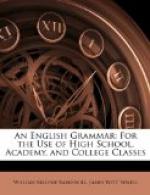(8) These words also show confusion and consequent modification, coming about as follows: further really belongs to another series,—forth, further, first. First became entirely detached from the series, and furthest began to be used to follow the comparative further; then these were used as comparative and superlative of far.
The word far had formerly the comparative and superlative farrer, farrest. In imitation of further, furthest, th came into the others, making the modern farther, farthest. Between the two sets as they now stand, there is scarcely any distinction, except perhaps further is more used than farther in the sense of additional; as, for example,—
When that evil principle
was left with no further material to
support it.—HAWTHORNE.
(9) Latter and last are the older forms. Since later, latest, came into use, a distinction has grown up between the two series. Later and latest have the true comparative and superlative force, and refer to time; latter and last are used in speaking of succession, or series, and are hardly thought of as connected in meaning with the word late.
(10) Hinder is comparative in form, but not in meaning. The form hindmost is really a double superlative, since the m is for _-ma_, an old superlative ending, to which is added _-ost_, doubling the inflection. Hind-er-m-ost presents the combination comparative + superlative + superlative.
[Sidenote: List II.]
165. In List II. (Sec. 163) the comparatives and superlatives are adjectives, but they have no adjective positives.
The comparatives are so in form, but not in their meaning.
The superlatives show examples again of double inflection, and of comparative added to double-superlative inflection.
Examples (from Carlyle) of the use of these adjectives: “revealing the inner splendor to him;” “a mind that has penetrated into the inmost heart of a thing;” “This of painting is one of the outermost developments of a man;” “The outer is of the day;” “far-seeing as the sun, the upper light of the world;” “the innermost moral soul;” “their utmost exertion.”
[Sidenote: -Most added to other words.]
166. The ending _-most_ is added to some words that are not usually adjectives, or have no comparative forms.
There, on the very topmost
twig, sits that ridiculous but
sweet-singing bobolink.—H.W.
BEECHER.
Decidedly handsome,
having such a skin as became a young woman of
family in northernmost
Spain.—DE QUINCEY.
Highest and midmost,
was descried The royal banner floating
wide.—SCOTT.




